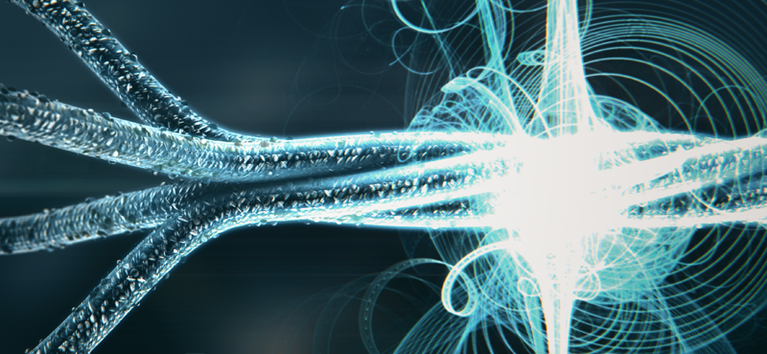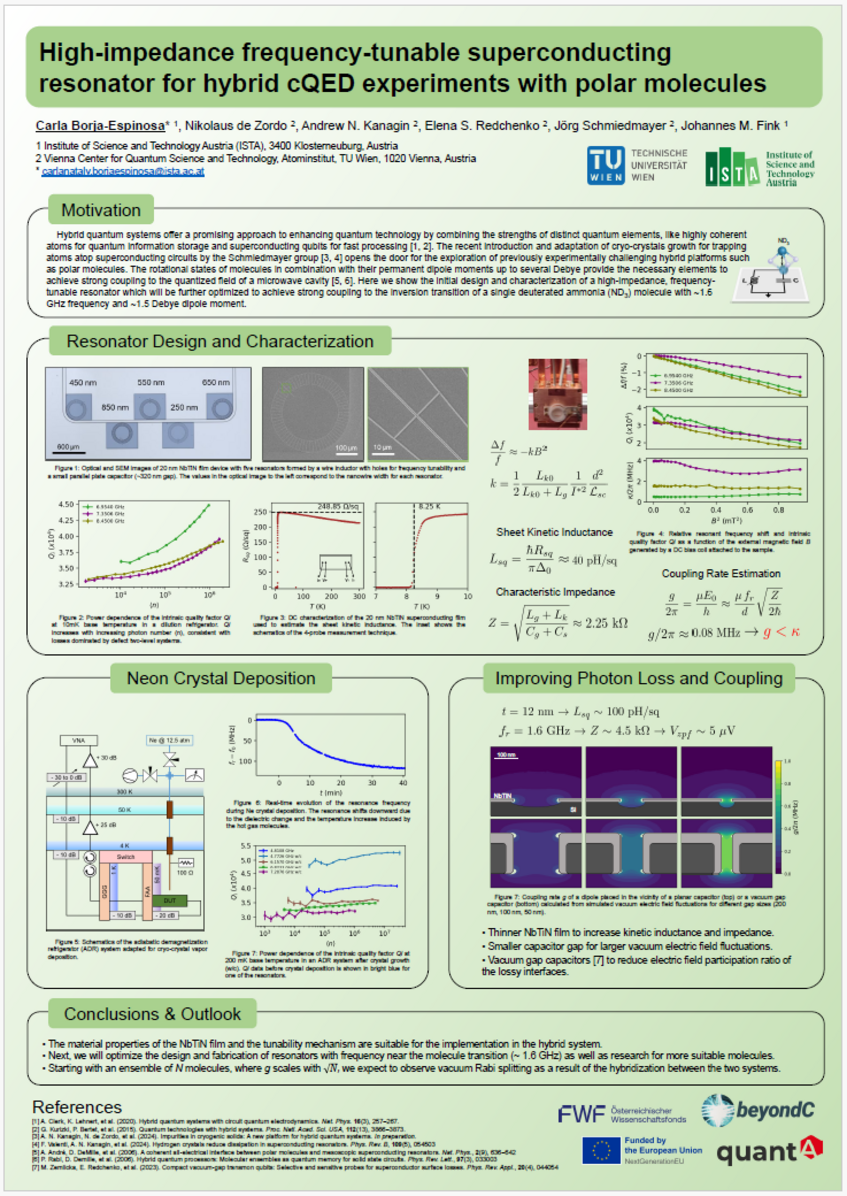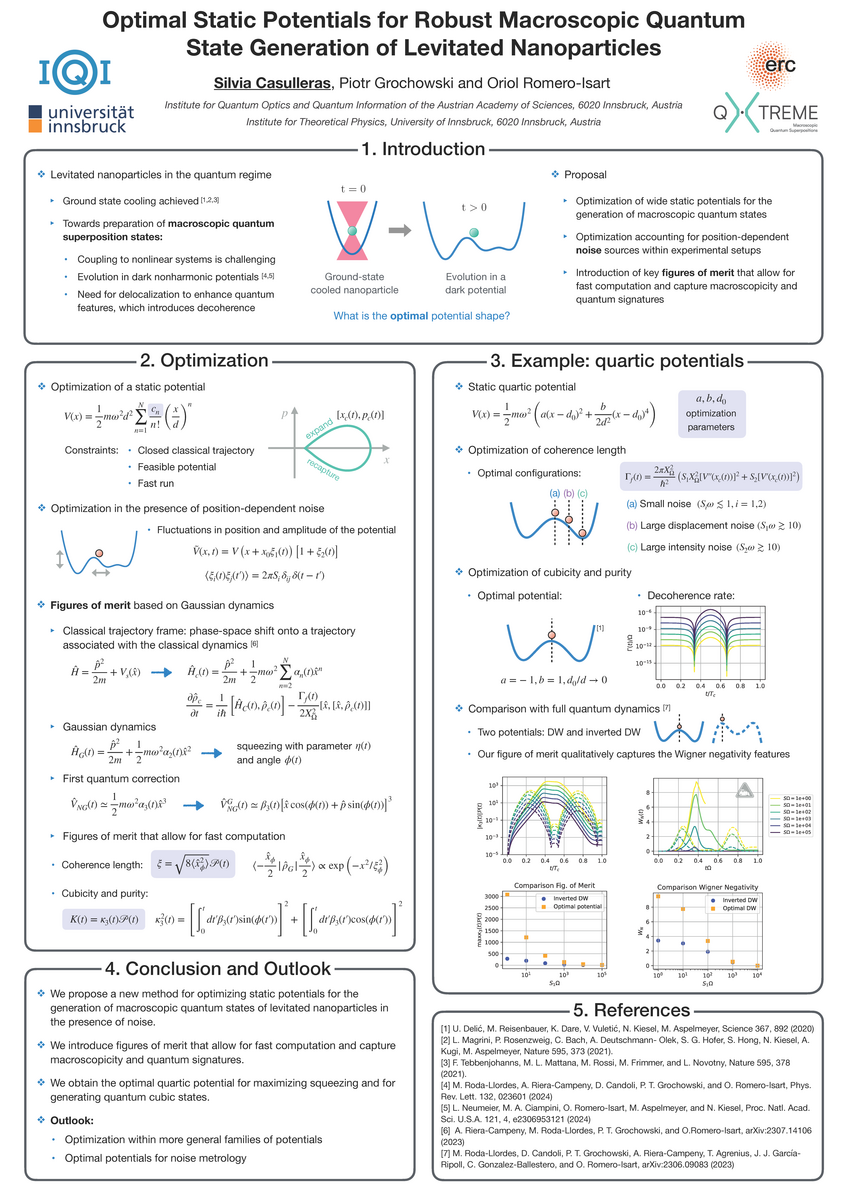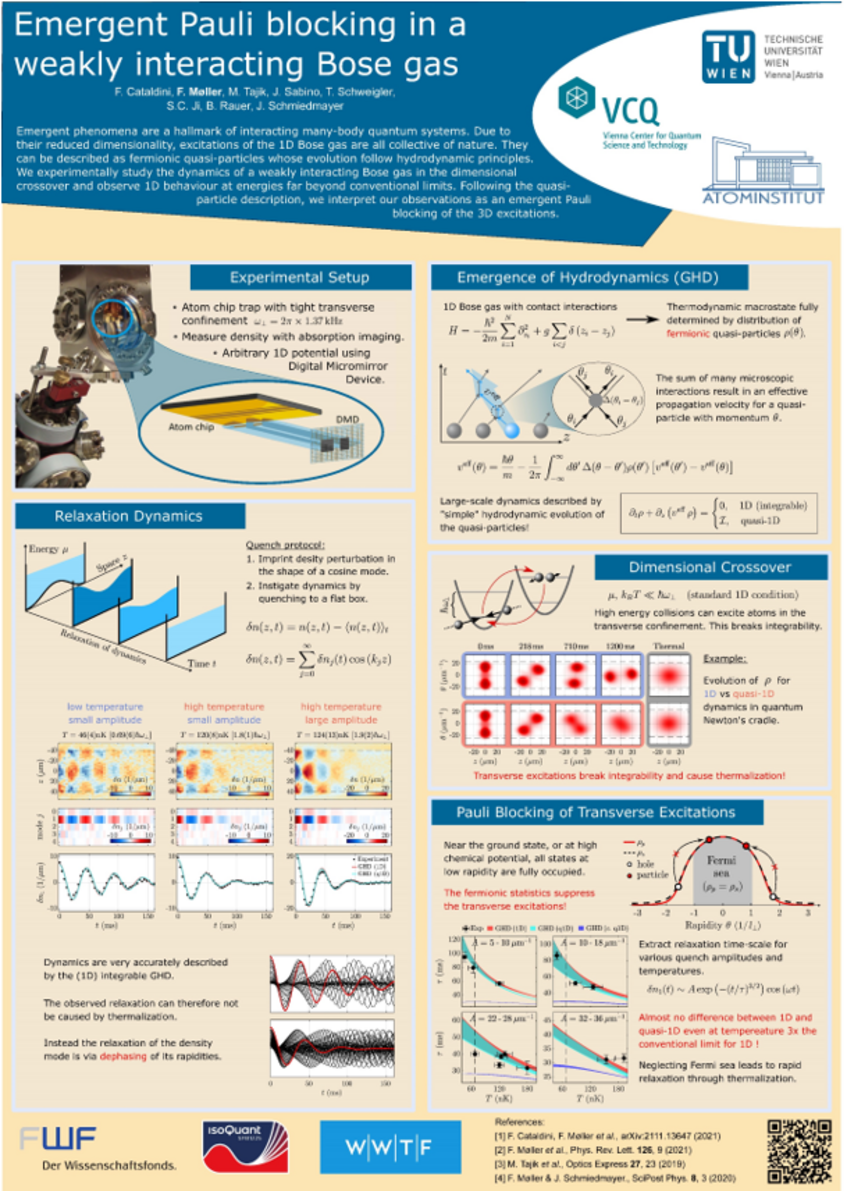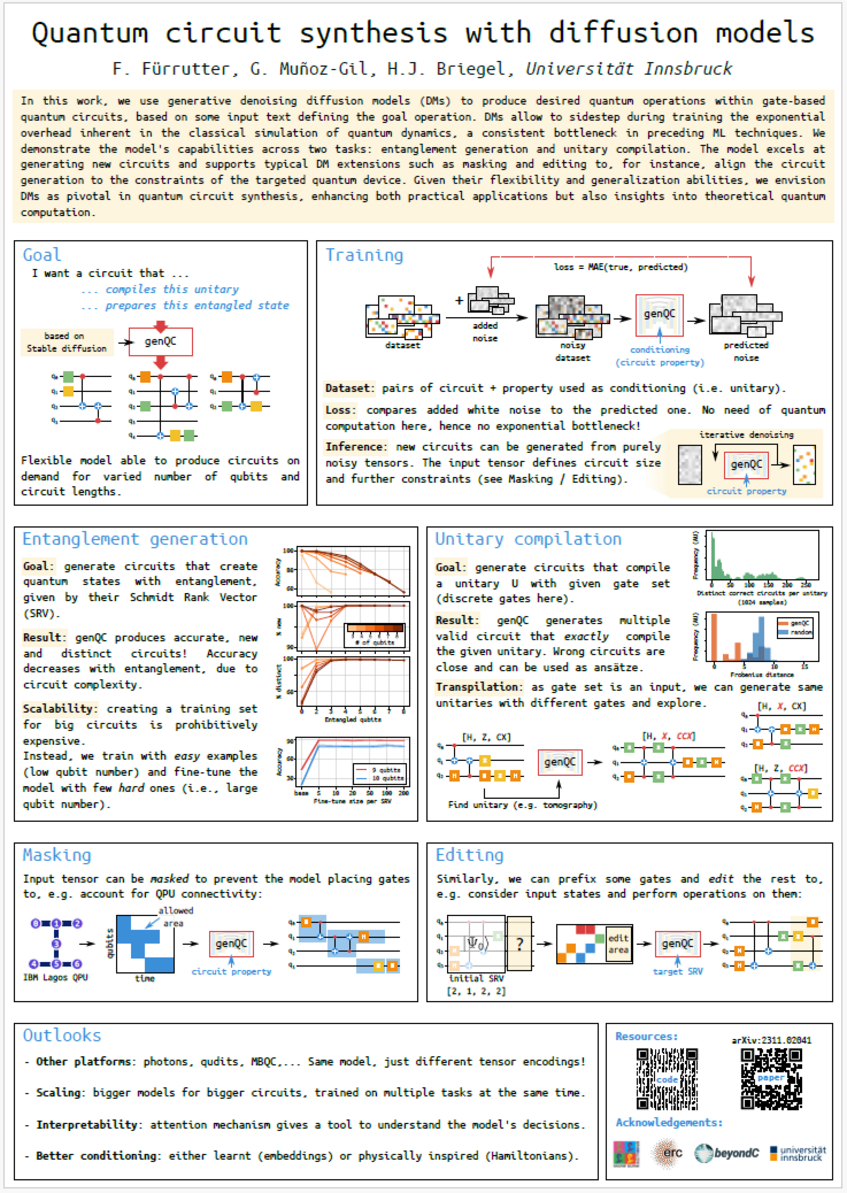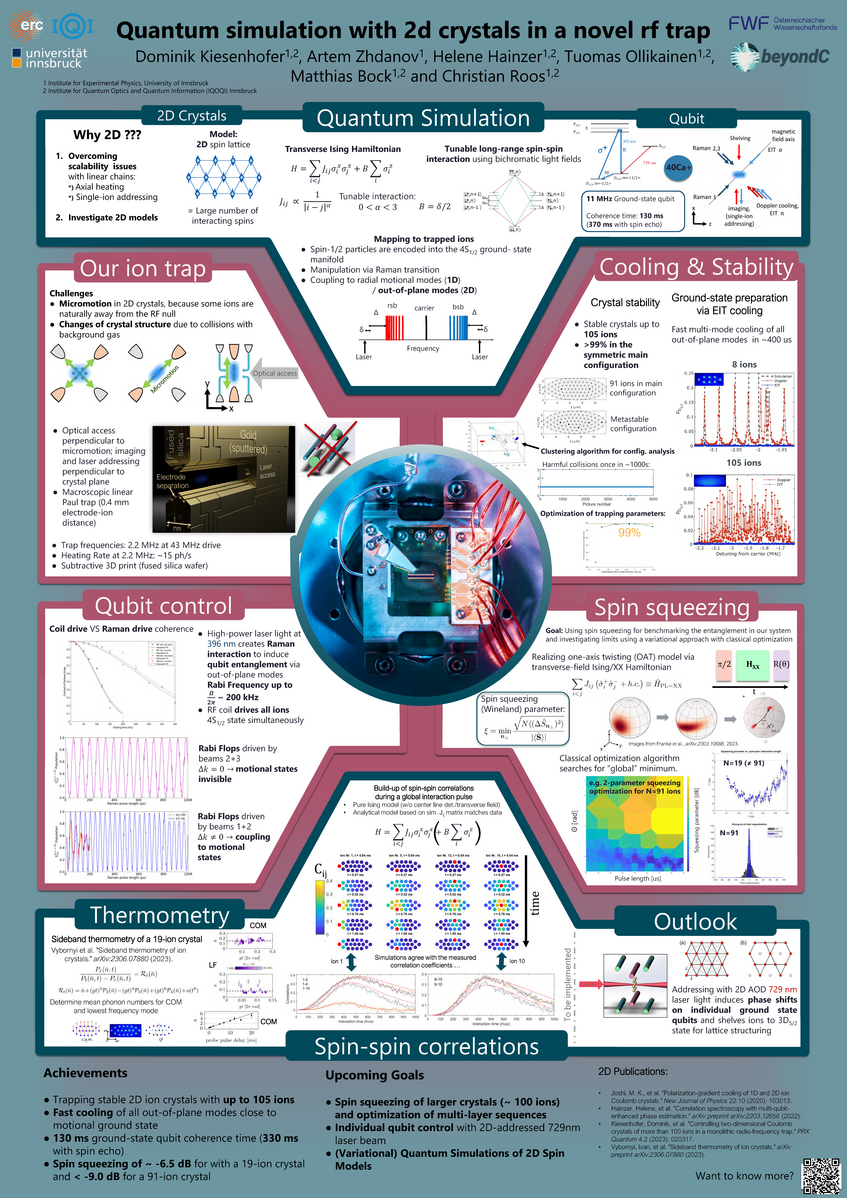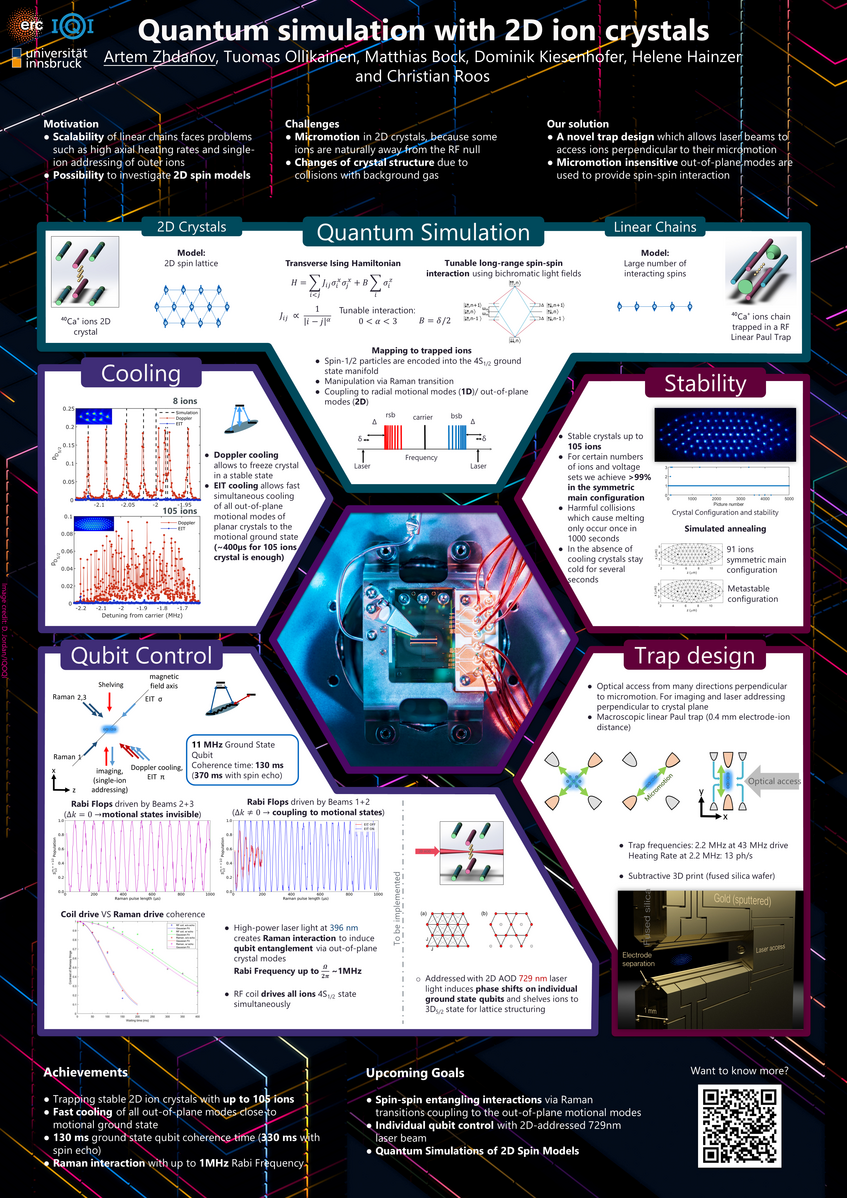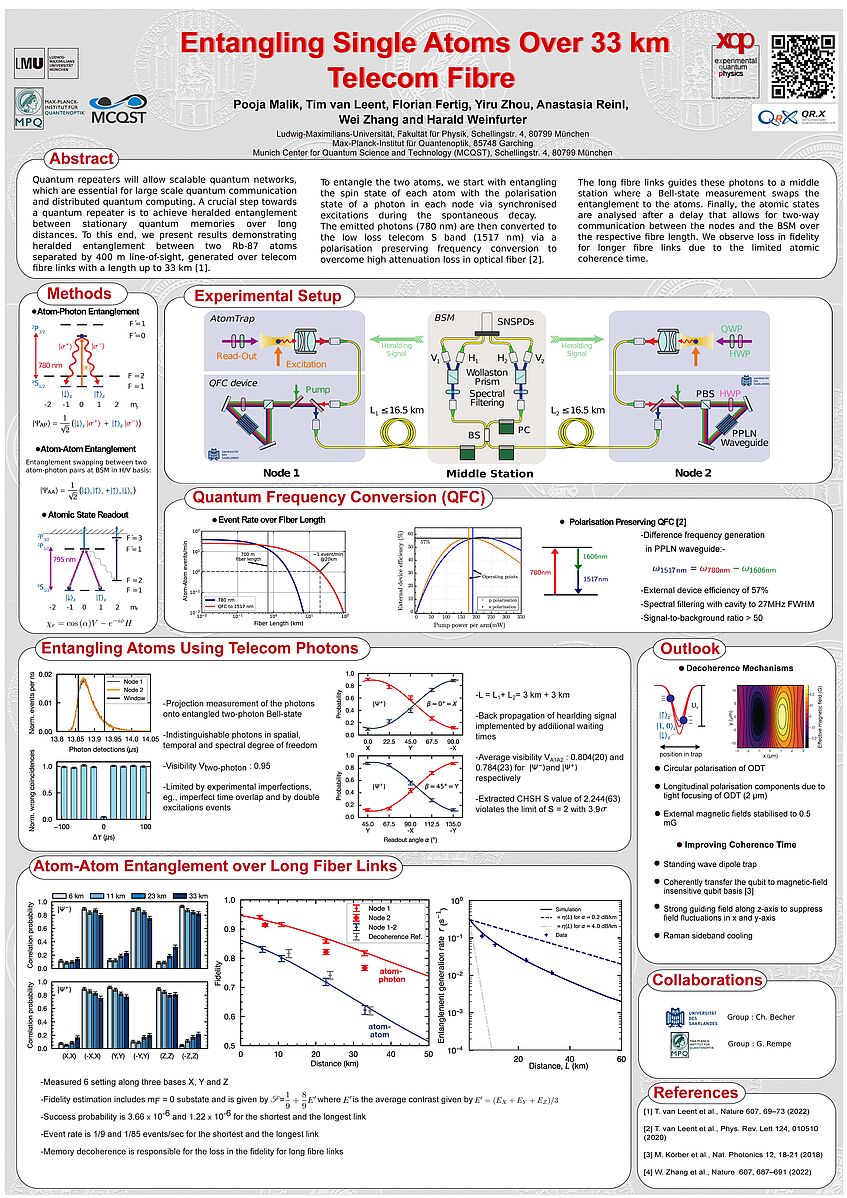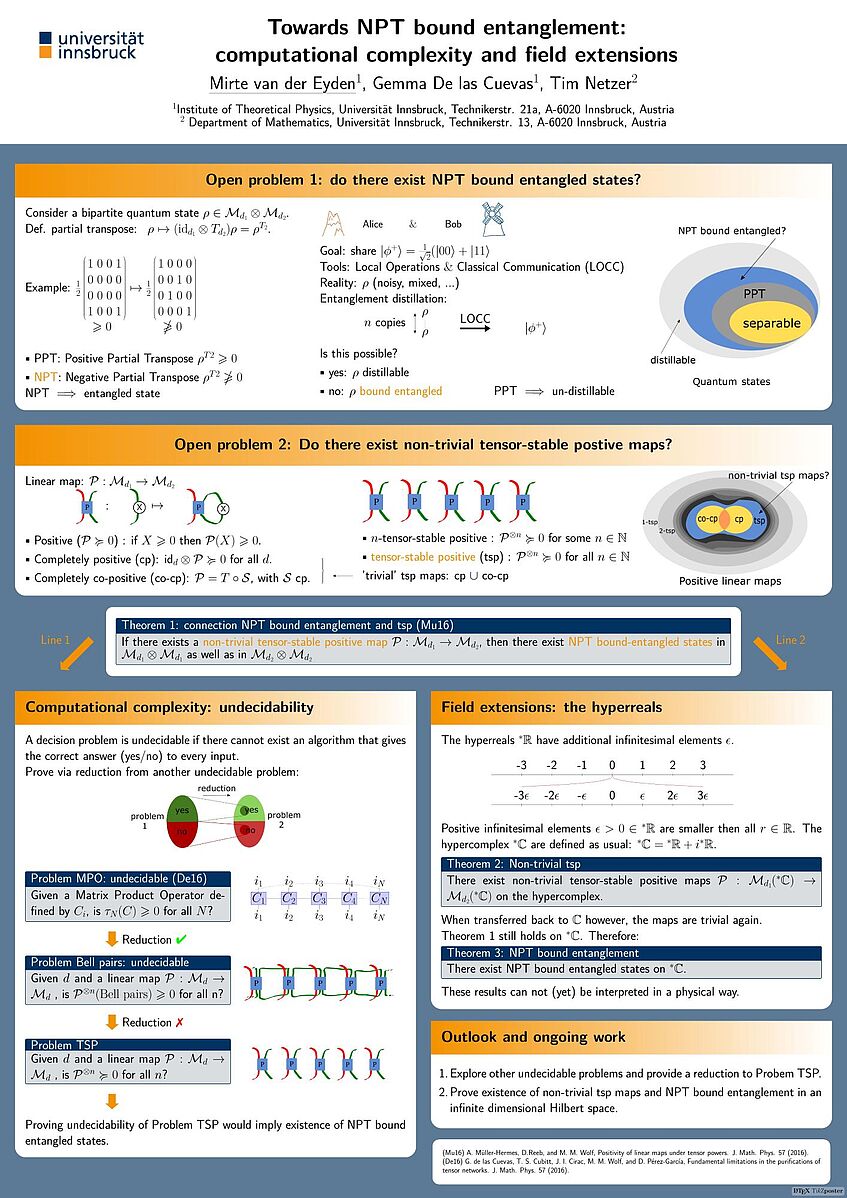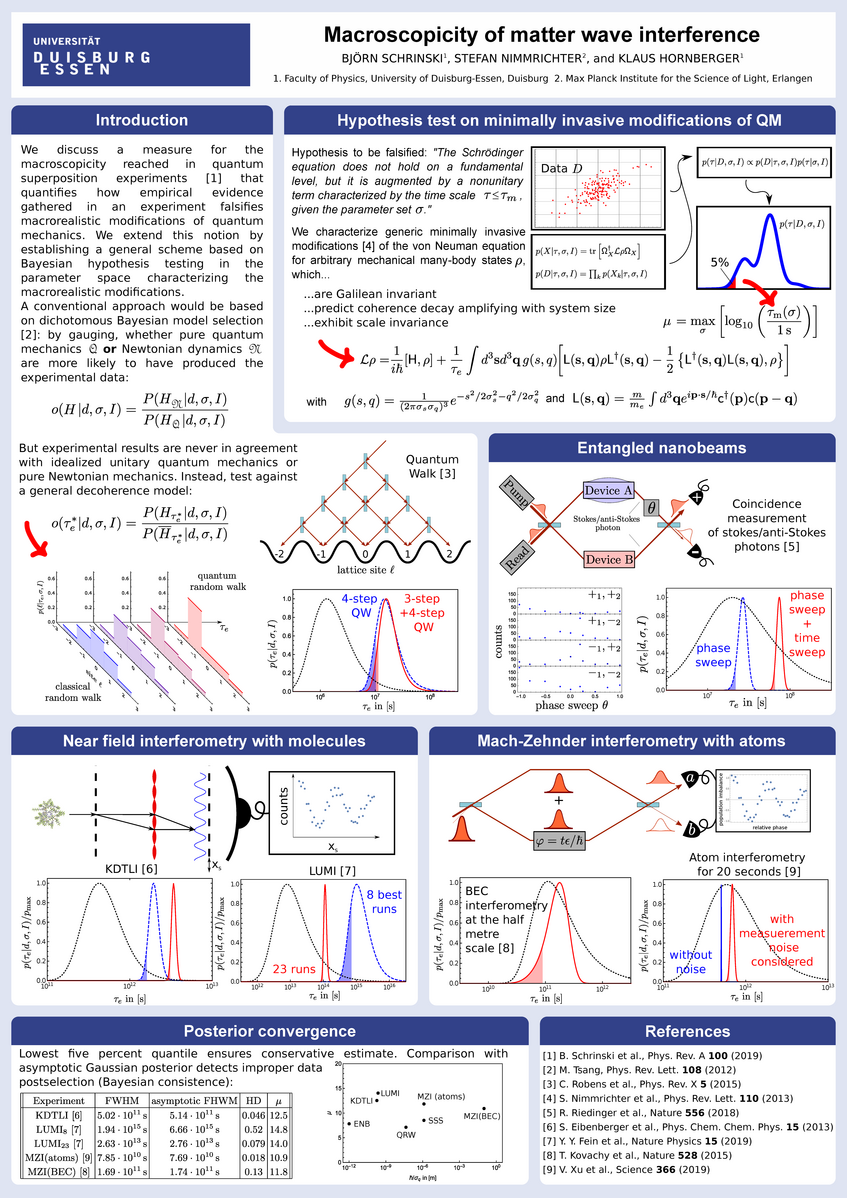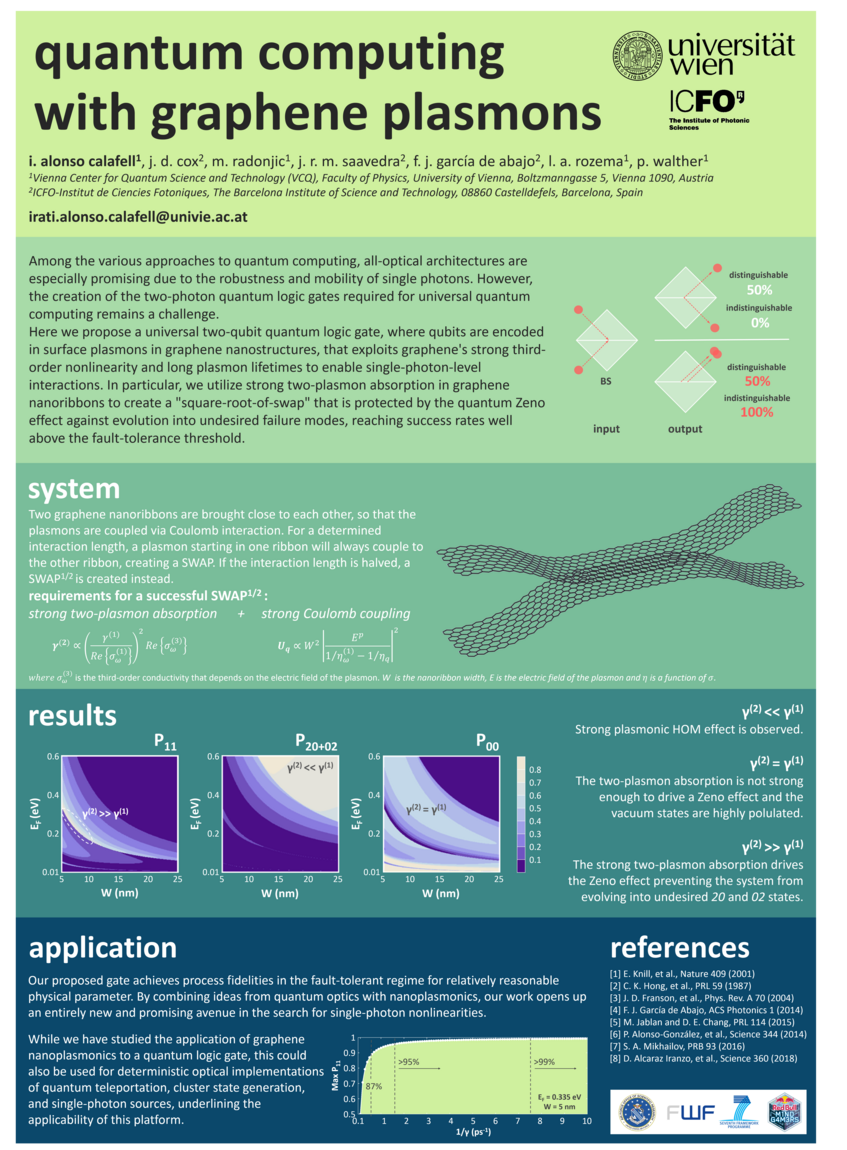Best Poster Award
SFB BeyondC encourages young researchers to present their results in poster sessions at the SFB events. The "Best Poster Award" is awarded twice a year and is currently endowed with 300 euros.
Here you can find all the winning posters of the "Best Poster Award":
High-impedance frequency-tunable superconducting resonator for hybrid cQED experiments with polar molecules
Carla Nataly Borja Espinosa
ISTA
SFB BeyondC Winter Workshop 2025
Over the past decade, one-dimensional (1D) ultracold gases trapped on atom chips have proven a poweHybrid quantum systems offer a promising approach to enhancing quantum technology by combining the strengths of distinct quantum elements, like highly coherent atoms for quantum information storage and superconducting qubits for fast processing [1,2]. The recent introduction and adaptation of cryo-crystals growth for trapping atoms atop superconducting circuits by the Schmiedmayer group [3,4] opens the door for the exploration of previously experimentally challenging hybrid platforms such as polar molecules. The rotational states of molecules in combination with their permanent dipole moments up to several Debye provide the necessary elements to achieve strong coupling to the quantized field of a microwave cavity [5,6]. Here we show the initial design and characterization of a high impedance, frequency tunable resonator which will be further optimized to achieve strong coupling to the inversion transition of a single deuterated ammonia (ND3) molecule with 1.6 GHz frequency and 1.5 Debye dipole moment.
Optimal Static Potentials for Robust Macroscopic Quantum State Generation of Levitated Nanoparticles
Silvia Casulleras
University of Innsbruck
SFB BeyondC Winter Workshop 2024
Levitated nanoparticles oer a unique and controlled experimental platform for in vestigating quantum phenomena at the interface between classical and quantum me- chanics. The ground-state cooling of nanoparticles in optical traps was recently achieved, and the current pursuit is directed towards the preparation of macro-scopic quantum superposition states. Due to substantial decoherence in optical potentials, the dynamics must happen either in the absence of an optical potential or within a dark potential. A specific nonharmonic potential has been identified for generating these macroscopic quantum superpositions, yet the optimal potential shape remains unknown. We address this question by using an optimization approach to determine the optimal static potential shape for robust generation of macroscopic quantum states. Our optimization strategy accounts for inherent noise sources within experimental setups. Given the computational demands of the multiscale simulation of this system, we provide a description of the dynamics that allows for fast computation of key figures of merit. Specifically, we use coherence length and cubicity of the state as indicators for the emergence of nonclassical features. We find that the optimal potential shape varies based on the strength and nature of the noise in the system. Our research shows that optimization can provide valuable insights for enhanced control over quantum features in levitated nanoparticle systems.
Emergent Pauli blocking in a weakly interacting Bose gas
Frederik Møller
Atominstitut, TU Vienna
SFB BeyondC Winter Workshop 2024
Over the past decade, one-dimensional (1D) ultracold gases trapped on atom chips have proven a powerful platform for studying the emergent physics of quantum many-body systems. Using techniques of in-situ imaging and matter-wave interference, along with advances analysis techniques, transport and higher-order correlation functions on the emergent scale can be probed. I will present an overview of the capabilities and limitations of these approaches, focusing, in particular, on recent results regarding transport: In a series of experiments, a fully adjustable 1D potential was employed to per-form highly controlled quenches, where measurements of the subsequent dynamics facilitate testing the predictions of transport theories such as Generalized Hydro-dynamics (GHD). Indeed, following quenches of a single momentum mode of the condensate, a surprisingly good agreement with GHD predictions was found, even at relatively high energies. In highly energetic 1D systems, 3D scattering events are known to break integrability and drive the system towards thermalization. However, as identified by the Bethe Ansatz, the elementary excitations of the 1D Bose gas are actually fermionic; the slow relaxation observed (in agreement with 1D GHD) can be explained via an emergent Pauli blocking of the non-integrable scattering and is thus an indication of the underlying quasi-particle statistics.
Quantum circuit synthesis with diffusion models
Gorka Muñoz-Gil
University of Innsbruck
SFB BeyondC Winter Workshop 2024
Quantum computing has recently emerged as a transformative technology. Yet, ist promised advantages rely on eciently translating quantum operations into viable physical realizations. In this work, we use generative machine learning models, specifically denoising diusion models (DMs), to facilitate this transformation. Leveraging text-conditioning, we steer the model to produce desired quantum operations within gate-based quantum circuits. Notably, DMs allow to sidestep during training the exponential overhead inherent in the classical simulation of quantum dynamics—a consistent bottleneck in preceding ML techniques. We demonstrate the model’s capabilities across two tasks: entanglement generation and unitary compilation. The model excels at generating new circuits and supports typical DM extensions such as masking and editing to, for instance, align the circuit generation to the constraints of the targeted quantum device. Given their flexibility and generalization abilities, we envision DMs as pivotal in quantum circuit synthesis but also in many other platforms, from qudit processor and measurement-based computation to quantum optic experiments.
Quantum simulation with 2d crystals in a novel rf trap
Dominik Kiesenhofer
University of Innsbruck
SFB BeyondC Autumn Workshop 2023
Trapped ions in rf traps are a well-established platform for analog and variational quantum simulation of quantum many-body systems. Up to now, ions in linear Paul traps allow for experiments with up to 50 spins in a linear configuration including quantum control of individual qubits. In our project, we aim for extending this approach to the second dimension enabling studies of 2d spin models with a larger particle number. Using a novel micro-fabricated linear Paul trap, we are able to stably trap and ground-state cool 2d ion crystals of up to 105 ions laying the foundation for future quantum simulation experiments. Moreover, we successfully realize spin-spin interactions by coupling laser fields to the out-of-plane vibrational modes and assess these interactions using spin-squeezing experiments. In this poster, we give an overview of our experimental apparatus and the results achieved so far.
Quantum simulation with 2D ion crystals
Artem Zhdanov
University of Innsbruck
SFB BeyondC Workshop 2023: Kickoff 2.0
Our project aims to move trapped ions quantum simulation platform beyond 1D chains while maintaining a full control on a single ion level. Making 2D ion crystals immediately unlocks the possibility of simulation of spin lattices, a challenging model to simulate using linear strings. To reach this goal we use custom designed monolithic Paul trap, which is capable of maintaining tens of calcium ions in a stable stationary crystal configurations. With this poster, I would like to give an overview of our project, the main advantages and obstacles of our approach and the results achieved so far on our way to 2D quantum simulation.
Entangling Single Atoms Over 33 km Telecom Fibre
Pooja Malik
Ludwig Maximilian University of Munich
SFB BeyondC Conference 2022
Quantum repeaters will allow scalable quantum networks, which are essential for large scale quantum communication and distributed quantum computing. A crucial step towards a quantum repeater is to achieve heralded entanglement between stationary quantum memories over long distances. To this end, we present results demonstrating heralded entanglement between two Rb-87 atoms separated by 400 m line-of-sight, generated over telecom fibre links with a length up to 33 km [1]. To entangle the two atoms, we start with entangling the spin state of each atom with the polarisation state of a photon in each node via synchronised excitations during the spontaneous decay. The emitted photons (780 nm) are then converted to the low loss telecom S band (1517 nm) via a polarisation preserving frequency conversion to overcome high attenuation loss in optical fiber [2]. The long fibre links guides these photons to a middle station where a Bell-state measurement swaps the entanglement to the atoms. Finally, the atomic states are analysed after a delay that allows for two-way communication between the nodes and the BSM over the respective fibre length. We observe loss in fidelity for longer fibre links due to the limited atomic coherence time.
Reassessing the computational advantage of quantum-controlled ordering of gates
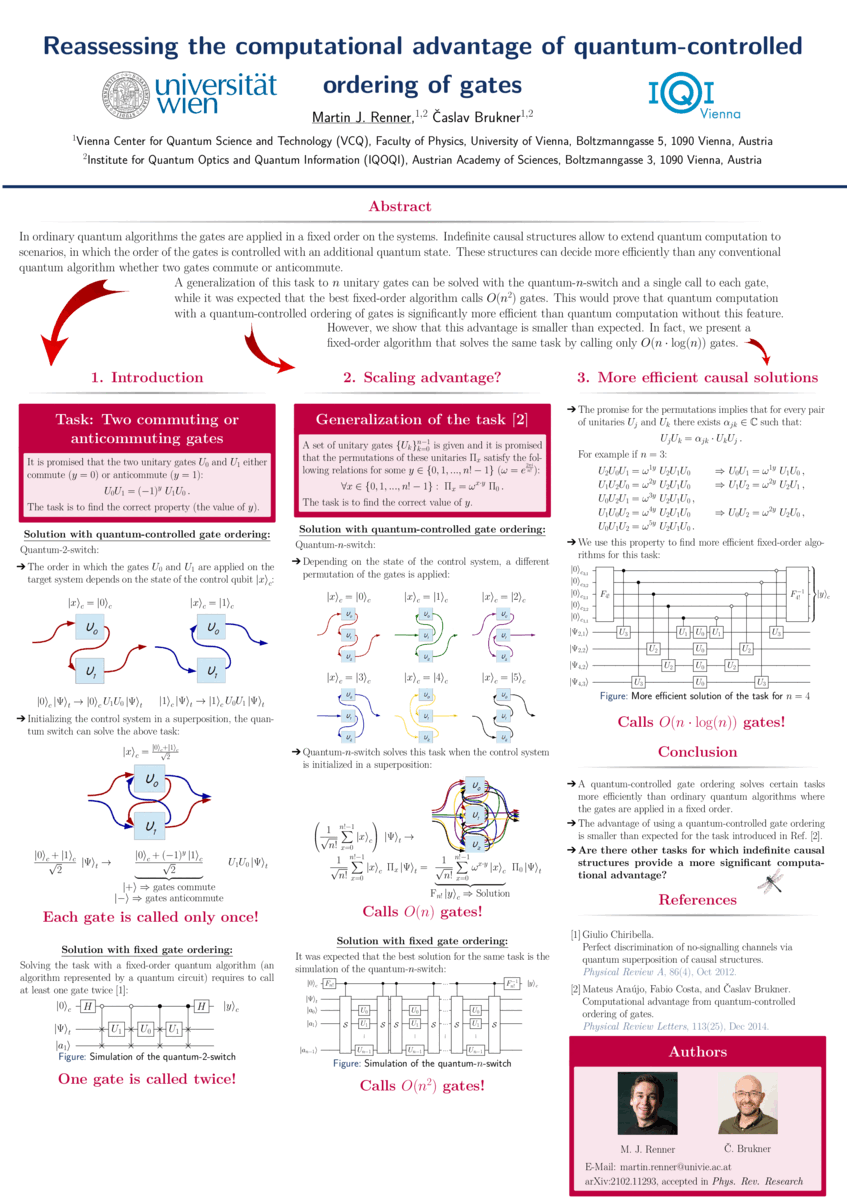
Martin Johannes Renner
University of Vienna
SFB BeyondC Autumn Workshop 2021
In quantum computation, indefinite causal structures allow to perform certain tasks more efficiently than any conventional (causal) quantum algorithm. For example, the quantum switch can decide whether two unitary gates commute or anticommute with a single call to each gate, while in any causal quantum algorithm at least one gate has to be called twice. A generalization of this task to n unitary gates, can be solved with the quantum-n-switch and a single call to each gate, while it was expected that the best causal algorithm calls O(n2) gates. We present more efficient causal lgorithms for this task and conclude that this advantage is smaller than expected so far.
Towards NPT bound entanglement: computational complexity and field extensions
Mirte van der Eyden
University of Innsbruck
SFB BeyondC Winter Workshop 2021
One of the classic open problems in quantum information is the existence of bound entangled states with a non-positive partial transpose (NPT). This problem is related to the positivity of linear maps under tensor powers. In our ongoing work we prove undecidability of the following problem: is a given linear map positive under tensor powers when the input are neighbouring Bell pairs? Proving undecidability of the same question without a specified input would prove existence of NPT bound entangled states. However, we show that the most natural reduction to this more general problem is not possible. In a second line of research we prove existence of NPT bound entangled states considered on the hyper-complex field.
Macroscopicity of Matter Wave Interference
Björn Schrinski
Universität Duisburg-Essen
International Conference on Quantum Optics 2020
One driving force to motivate interference experiments involving high masses,long interference times, and large path separations is to verify the validity of theSchrödinger equation on ever larger scales. The degree of macroscopicity can beassessed by the amount of falsified modifications of quantum mechanics (collapsemodels [1]) which may be quantified with help of the underlying parameter space [2]. We focus on the fundamental measurement outcomes by applying Bayesianparameter estimation [3] and discuss state of the art experiments [4,5,6].
[1] Bassi et al., Rev. Mod. Phys. 85 (2013) [2] Nimmrichter et al., Phys. Rev.Lett. 110 (2013) [3] Schrinski et al., Phys. Rev. A 100 (2019) [4] Kovachy et al.,Nature 528 (2015) [5] Fein et al., Nat. Phys. (2019) [6] Xu et al., Science 366 (2019)
Quantum Computing with Graphene Plasmons
Irati Alonso Calafell, J. D. Cox, M. Radonjić, J. R. M. Saavedra, F. J. García de Abajo, L. A. Rozema, P. Walther University of Vienna
University of Vienna
Austrian Quantum Information Conference 2019
Among the various approaches to quantum computing, all-optical architectures are especially promising due to the robustness and mobility of single photons. However, the creation of the two-photon quantum logic gates required for universal quantum computing remains a challenge. Here we propose a universal two-qubit quantum logic gate, where qubits are encoded in surface plasmons in graphene nanostructures, that exploits graphene's strong third-order nonlinearity and long plasmon lifetimes to enable single-photon-level interactions. In particular, we utilize strong two-plasmon absorption in graphene nanoribbons, which can greatly exceed single-plasmon absorption to create a “square-root-of-swap” that is protected by the quantum Zeno effect against evolution into undesired failure modes. Our gate does not require any cryogenic or vacuum technology, has a footprint of a few hundred nanometers, and reaches fidelities and success rates well above the fault-tolerance threshold, suggesting that graphene plasmonics offers a route towards scalable quantum technologies.
